Evaluation of Control Effect of Confined Water Hazard in Taiyuan Formation Coal Seam Mining in Huanghebei Coalfield
Abstract
1. Introduction
2. Methodology
2.1. Overview of the Research Area
2.2. Establishment of Evaluation Scheme
3. Evaluation of Grouting Reconstruction Effect
3.1. Classification Result Based on GIS
3.2. Verification of Mine Electrical Prospecting
3.2.1. Geophysical Characteristics of the Study Area
3.2.2. Exploration Results
3.3. Contrastive Analysis
4. Discussion
4.1. Comparative Analysis of GIS Classification Evaluation and Underground Drilling Verification Evaluation
4.2. Optimization of Evaluation Method for Grouting Transformation Effect of Coalface
4.2.1. Coupling of Grouting Pressure and Grouting Volume
4.2.2. GIS Evaluation and Collaboration with Geophysical Exploration and Dense Drilling
5. Conclusions
- (1)
- Based on the data of grouting reinforcement in the floor of the 1101 coalface, an evaluation method using ArcGIS to determine the treatment effect of floor water hazards in a coal mining face was proposed;
- (2)
- Following the comparison and analysis of the evaluation test data yielded by ArcGIS and exploration via the mine electric method, the results show that the water pressure threshold based on the GIS system is double the water pressure of the grouting reconstruction layer, thus representing the optimal solution;
- (3)
- According to the comparative analysis between the data yielded by geophysical exploration and drilling and the model’s experiment results, the feasibility and accuracy of grouting effect evaluation based on GIS using grouting pressure data are verified. The results of this research can provide a reference for the prevention and control of floor water hazards in deep coal seam mining in North China.
Author Contributions
Funding
Institutional Review Board Statement
Informed Consent Statement
Data Availability Statement
Acknowledgments
Conflicts of Interest
References
- Wu, Q.; Liu, Y.; Zhou, W.; Li, B.; Zhao, B.; Liu, S.; Sun, W.; Zeng, Y. Evaluation of Water Inrush Vulnerability from Aquifers Overlying Coal Seams in the Menkeqing Coal Mine, China. Mine Water Environ. 2015, 34, 258–269. [Google Scholar] [CrossRef]
- Bense, V.F.; Van den Berg, E.H.; Van Balen, R.T. Deformation mechanisms and hydraulic properties of fault zones in unconsolidated sediments; the Roer Valley Rift System, The Netherlands. Hydrogeol. J. 2003, 11, 319–332. [Google Scholar] [CrossRef]
- Mokhov, A.V. Fissuring due to inundation of coalmines and its hydrodynamic implications. Dokl. Earth Sci. 2007, 414, 223–225. [Google Scholar] [CrossRef]
- Caine, J.S.; Minor, S.A. Structural and geochemical characteristics of faulted sediments and inferences on the role of water in deformation, Rio Grande Rift, New Mexico. Geol. Soc. Am. Bull. 2009, 121, 1325–1340. [Google Scholar] [CrossRef]
- Sun, Y.J.; Zheng, S.S.; Zhang, D.S.; Xia, Y.H. Preliminary application of information fitting method in prediction of floor water inrush in eastern Jiaozuo mining area. China Energy Environ. Prot. 1990, 02, 24–26. [Google Scholar]
- Zhang, Y.J.; Li, F.M. Prediction of water inrush from coal seam floors based on the effective barrier thickness. Mine Water Environ. 2022, 41, 168–175. [Google Scholar] [CrossRef]
- Wu, Q.; Zhang, Z.L.; Ma, J.F. A new practical methodology of the coal floor water bursting evaluating I—The master controlling index system construction. J. China Coal Soc. 2007, 32, 42–47. [Google Scholar]
- Wu, Q.; Zhang, Z.L.; Zhang, S.Y.; Ji-Fu, M. A new practical methodology of the coal floor water bursting evaluating II—The vulnerable index method. J. China Coal Soc. 2007, 158, 1121–1126. [Google Scholar]
- Wu, Q.; Xie, S.H.; Pei, Z.J.; Ma, J.F. A new practical methodology of the coal floor water bursting evaluating III—The application of ANN vulnerable index method based on GIS. J. China Coal Soc. 2007, 159, 1301–1306. [Google Scholar]
- Hu, Y.B.; Li, W.P.; Wang, Q.Q.; Liu, S.; Wang, Z. Evaluation of water inrush risk from coal seam floors with an AHP–EWM algorithm and GIS. Environ. Earth Sci. 2019, 78, 290. [Google Scholar] [CrossRef]
- Hu, Y.B.; Li, W.P.; Chen, X.M.; Xu, H.Z.; Liu, S.L. Temporal and spatial evolution characteristics of fracture distribution of floor strata in deep coal seam mining. Eng. Fail. Anal. 2022, 132, 105931. [Google Scholar] [CrossRef]
- Hu, Y.B.; Li, W.P.; Liu, S.L.; Wang, Q.Q. Prediction of Floor Failure Depth in Deep Coal Mines by Regression Analysis of the Multi-factor Influence Index. Mine Water Environ. 2021, 40, 497–509. [Google Scholar] [CrossRef]
- Li, J.X.; Li, B.Y. The theory of "lower three zones" of coal seam floor threatened by confined water and its application. China Energy Environ. Prot. 1990, 5, 6–8. [Google Scholar]
- Li, B.Y.; Shen, G.H.; Jing, Z.G.; Gao, H. Theory and practice of preventing water inrush from the floor of mining and excavation face. Saf. Coal Mines 1988, 5, 47–48. [Google Scholar]
- Hu, Y.B.; Li, W.B.; Wang, Q.Q.; Liu, S.L. Vertical shaft excavation shaping and surrounding rock control technology under the coupling action of high ground stress and fracture formation. J. Perform. Constr. Facil. 2020, 34, 04020116. [Google Scholar] [CrossRef]
- Li, B.Y. The Theory of "Lower Three Zones" for Preventing Water Burst from Mine Floor and Its Development and Application. J. Shandong Inst. Min. Technol. Nat. Sci. 1999, 8, 11–18. [Google Scholar] [CrossRef]
- Qian, M.G.; Miao, X.X.; Xu, J.L. Study on Key Stratum Theory in Rock Stratum Control. J. China Coal Soc. 1996, 3, 2–7. [Google Scholar]
- Miao, X.X. Review of research on mechanical behaviors of mining rock mass and its related engineering technological innovation progress. Chin. J. Rock Mech. Eng. 2010, 29, 1988–1998. [Google Scholar]
- Hu, Y.B.; Li, W.P.; Liu, S.L.; Wang, Q.Q.; Wang, Z.K. Risk assessment of water inrush from aquifers underlying the Qiuji coal mine in China. Arab. J. Geosci. 2019, 12, 98. [Google Scholar] [CrossRef]
- Hu, Y.B.; Li, W.B.; Wang, Q.Q.; Liu, S.L.; Wang, Z.K. Study on failure depth of coal seam floor in deep mining. Environ. Earth Sci. 2019, 78, 697. [Google Scholar] [CrossRef]
- Shi, Q.L.; Han, J. Theory and Practice of Dividing Coal Mining Area Floor into Four-Zone. J. China Univ. Min. Technol. 2005, 1, 19–26. [Google Scholar]
- Shi, Q.L. Summary of Research on Mechanism of Water-inrush from Seam Floor. J. Shandong Inst. Min. Technol. Nat. Sci. 2009, 28, 17–23. [Google Scholar] [CrossRef]
- Shi, L.Q.; Song, Z.Q. Theoretical Study on "Four Zones" Division of Stope Floor. J. Jiaozuo Inst. Technol. Nat. Sci. 2000, 19, 241–245. [Google Scholar]
- Yu, X.G.; Shi, Q.L.; Wei, J.C.; Li, S.C. Application of “Four Zone” Theory in Face Floor on Evaluation of Floor Water Inrush. J. Shandong Inst. Min. Technol. Nat. Sci. 2006, 25, 14–17. [Google Scholar] [CrossRef]
- Yin, L.M. Basic Experimental Study on Mechanism of Water Inrush from Floor in Deep Coal Seam Mining. Ph.D. Thesis, Shandong University of Science and Technology, Qingdao, China, 2011. [Google Scholar]
- Zhang, W.J.; Peng, Z.Y.; Han, C.H.; Chen, S.J. Numerical investigation of an equivalent hydraulic aperture for rough rock fractures based on cosimulation. Comput. Geotech. 2023, 156, 105281. [Google Scholar] [CrossRef]
- Zhang, J.C. Study on Failure and Seepage Characteristics of Mining Rock Mass. Ph.D. Thesis, China Coal Research Institute, Beijing, China, 1998. [Google Scholar]
- Wang, Y.; Han, J.Q.; Xia, Y.J.; Long, D.Y. New insights into the fracture evolution and instability warning predication for fissure-contained hollow-cylinder granite with different hole diameter under multi-stage cyclic loads. Theor. Appl. Fract. Mech. 2022, 119, 103363. [Google Scholar] [CrossRef]
- Wang, Y.; Su, Y.; Xia, Y.; Wang, H.; Yi, X. On the effect of confining pressure on fatigue failure of block-in-matrix soils exposed to multistage cyclic triaxial loads. Fatigue Fract. Eng. Mater. Struct. 2022, 45, 3356–3372. [Google Scholar] [CrossRef]
- Wang, Z.Y. "In situ tension fracture" theory of rock mass movement in coal seam floor. Hebei Coal 1988, 3, 29–31. [Google Scholar]
- Li, Q.; Han, Y.; Liu, X.; Ansari, U.; Cheng, Y.; Yan, C. Hydrate as a by-product in CO2 leakage during the long-term sub-seabed sequestration and its role in preventing further leakage. Environ. Sci. Pollut. Res. 2022, 29, 77737–77754. [Google Scholar] [CrossRef]
- Liu, S.J.; Lu, G.G. Application study on water disaster prevention and control technology of faults. China Energy Environ. Prot. 2019, 41, 29–32. [Google Scholar] [CrossRef]
- Bai, J.W.; Zhu, Z.J.; Liu, R.T.; Wang, M.; Zhang, Q.S.; Ma, H. Groundwater runoff pattern and keyhole grouting method in deep mines. Bull. Eng. Geol. Environ. 2021, 80, 5743–5755. [Google Scholar] [CrossRef]
- Li, Q.C.; Wu, J. Factors affecting the lower limit of the safe mud weight window for drilling operation in hydrate-bearing sediments in the Northern South China Sea. Geomech. Geophys. Geo-Energ. Geo-Resour. 2022, 8, 82. [Google Scholar] [CrossRef]
- Hu, Y.B.; Li, W.P.; Wang, Q.Q.; Chen, X.M.; Zheng, G. Evaluation Method of Water Hazard Control Effect of Coal Seam Floor in Deep Mining: Sequence Verification Evaluation. Geofluids 2022, 2022, 6728045. [Google Scholar] [CrossRef]
- Hu, Y.; Li, W.; Chen, X.; Zheng, G.; Li, X.; Wang, W. Application of brillouin optical time domain reflection technology for monitoring deformation and failure of the coal seam floor rock mass in deep underground mines. Mine Water Environ. 2022, 41, 1082–1095. [Google Scholar] [CrossRef]
- Hu, Y.B. Dynamic Evolution Law of Fracture Distribution and Water Inrush Risk Assessment in Deep Mining Coal Seam Floor; China University of Mining and Technology: Xuzhou, China, 2020. [Google Scholar] [CrossRef]
- Liu, H.L. Application of ground grouting and hydrophobic depressurization technology in treatment of water inrush in coal mine. China Energy Environ. Prot. 2018, 40, 78–80+116. [Google Scholar] [CrossRef]
- Li, Q.; Wang, F.; Wang, Y.; Zhou, C.; Chen, J.; Forson, K.; Miao, R.; Su, Y.; Zhang, J. Effect of reservoir characteristics and chemicals on filtration property of water-based drilling fluid in unconventional reservoir and mechanism disclosure. Environ. Sci. Pollut. Res. 2023, 30, 55034–55043. [Google Scholar] [CrossRef] [PubMed]
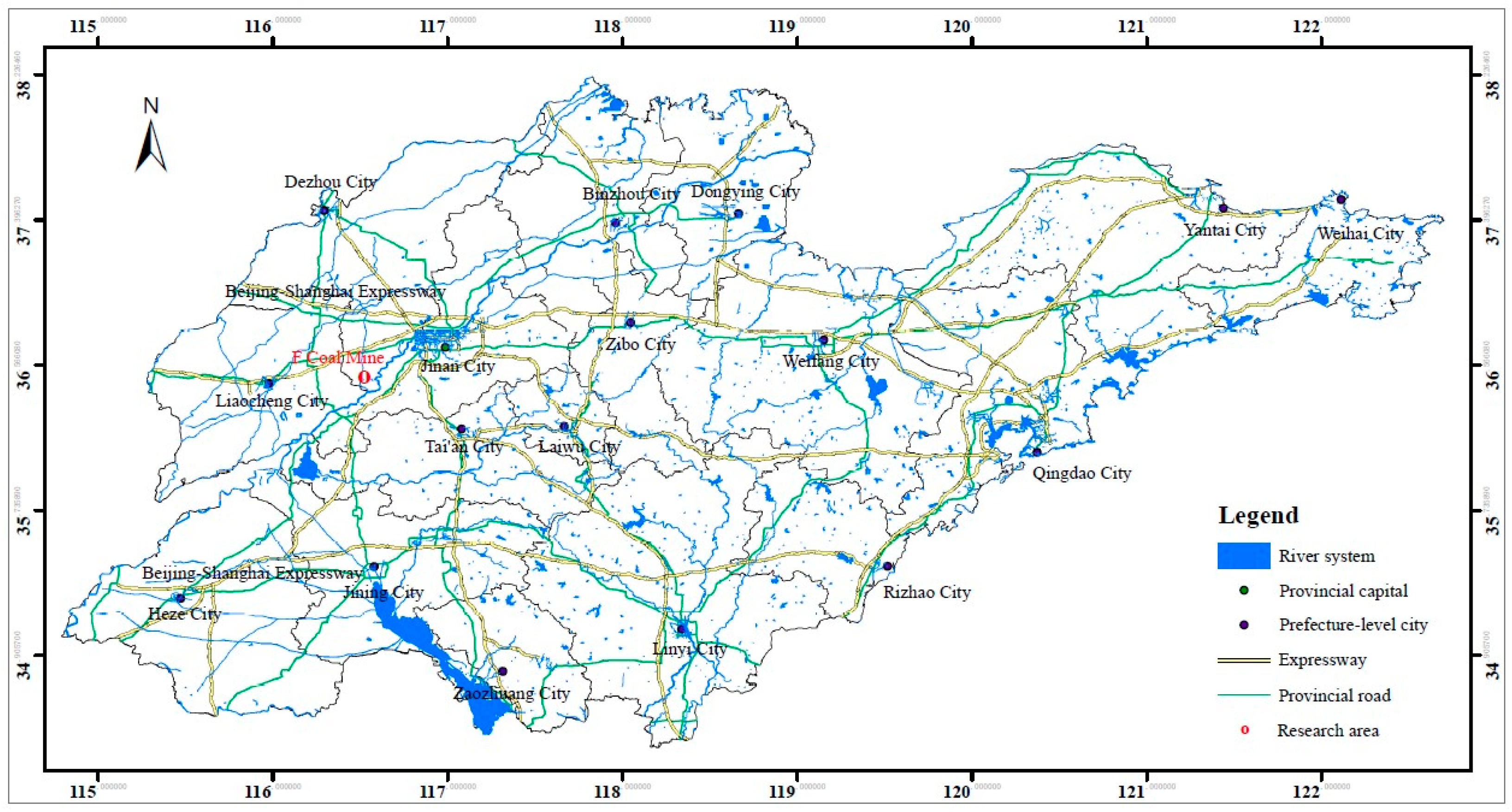
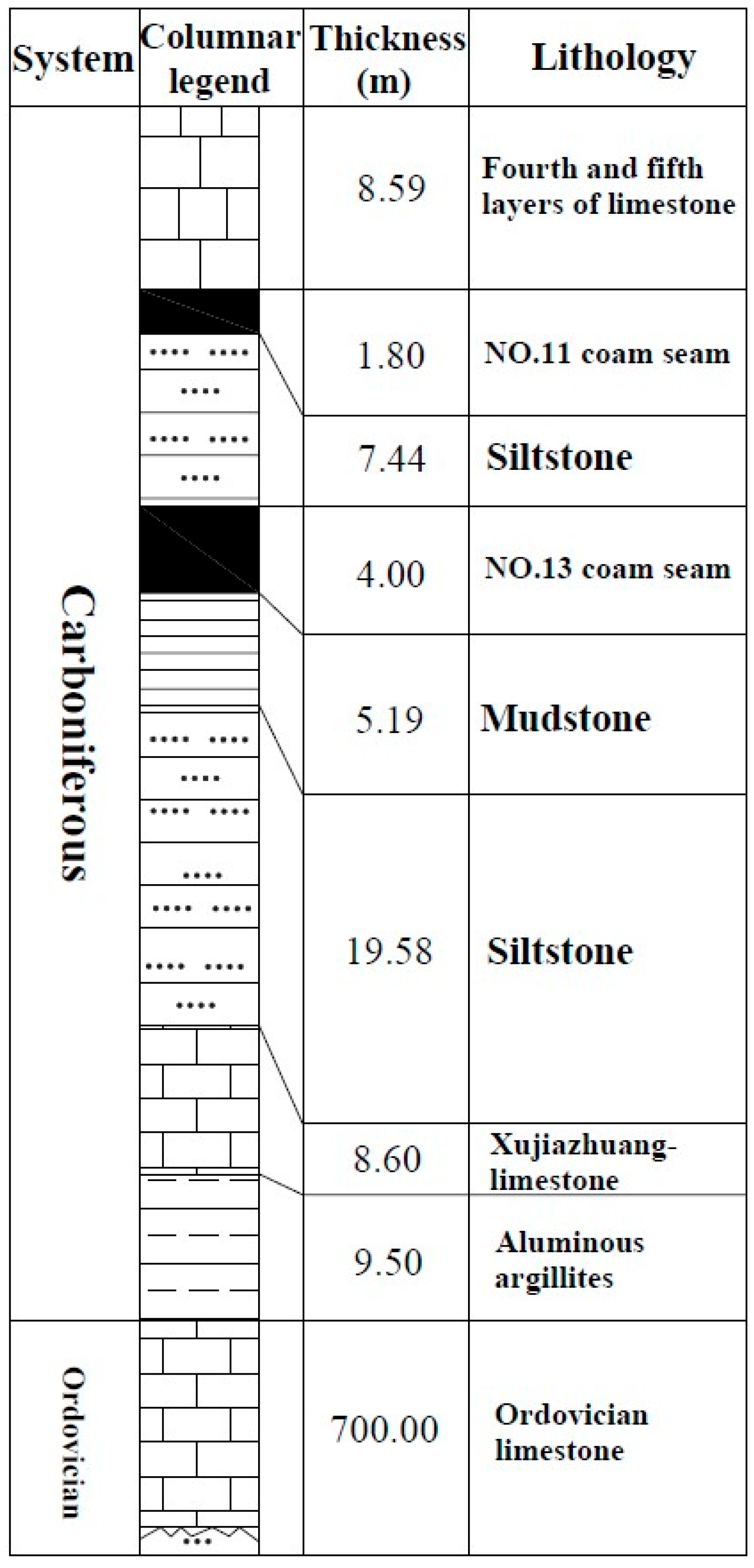


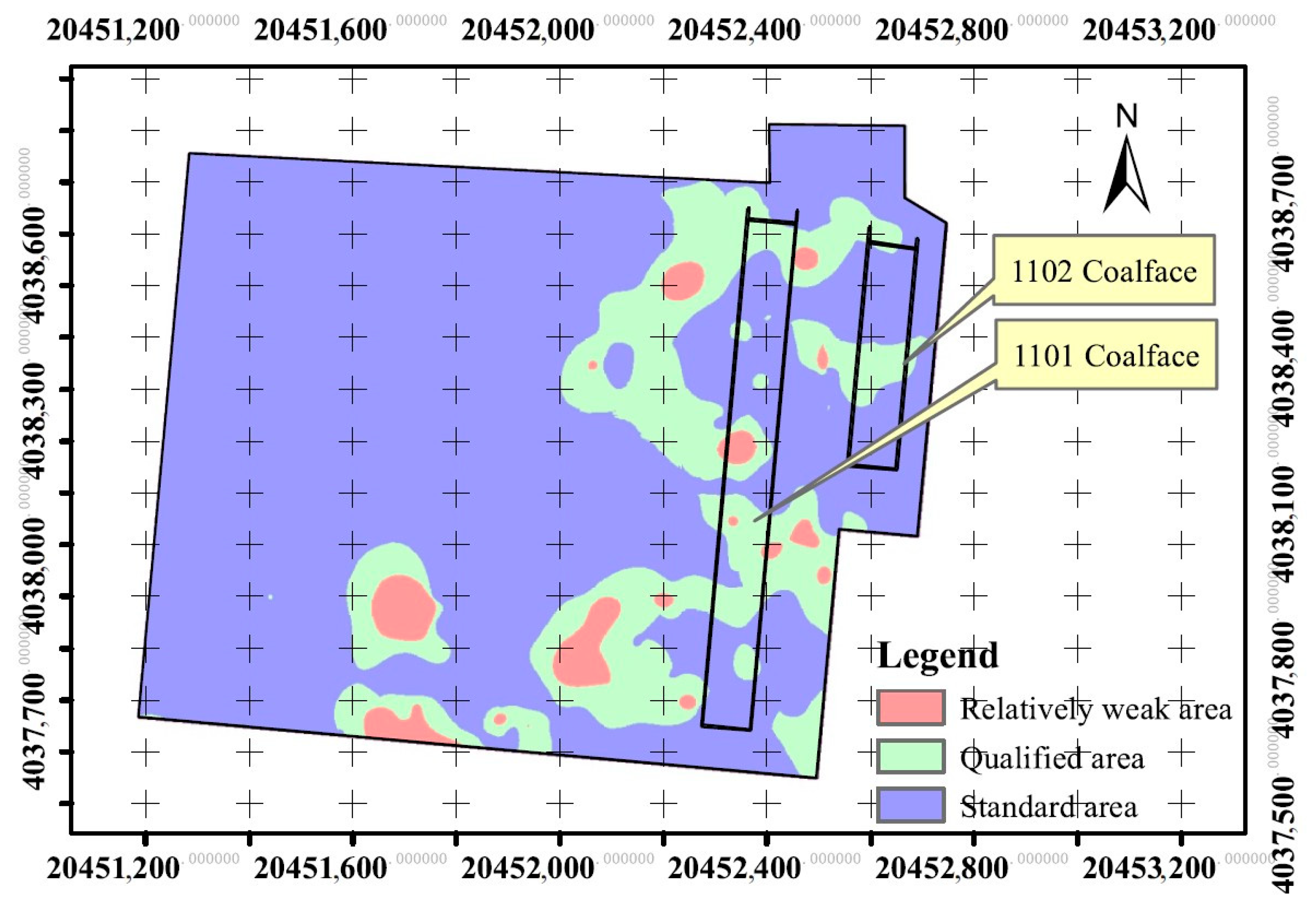
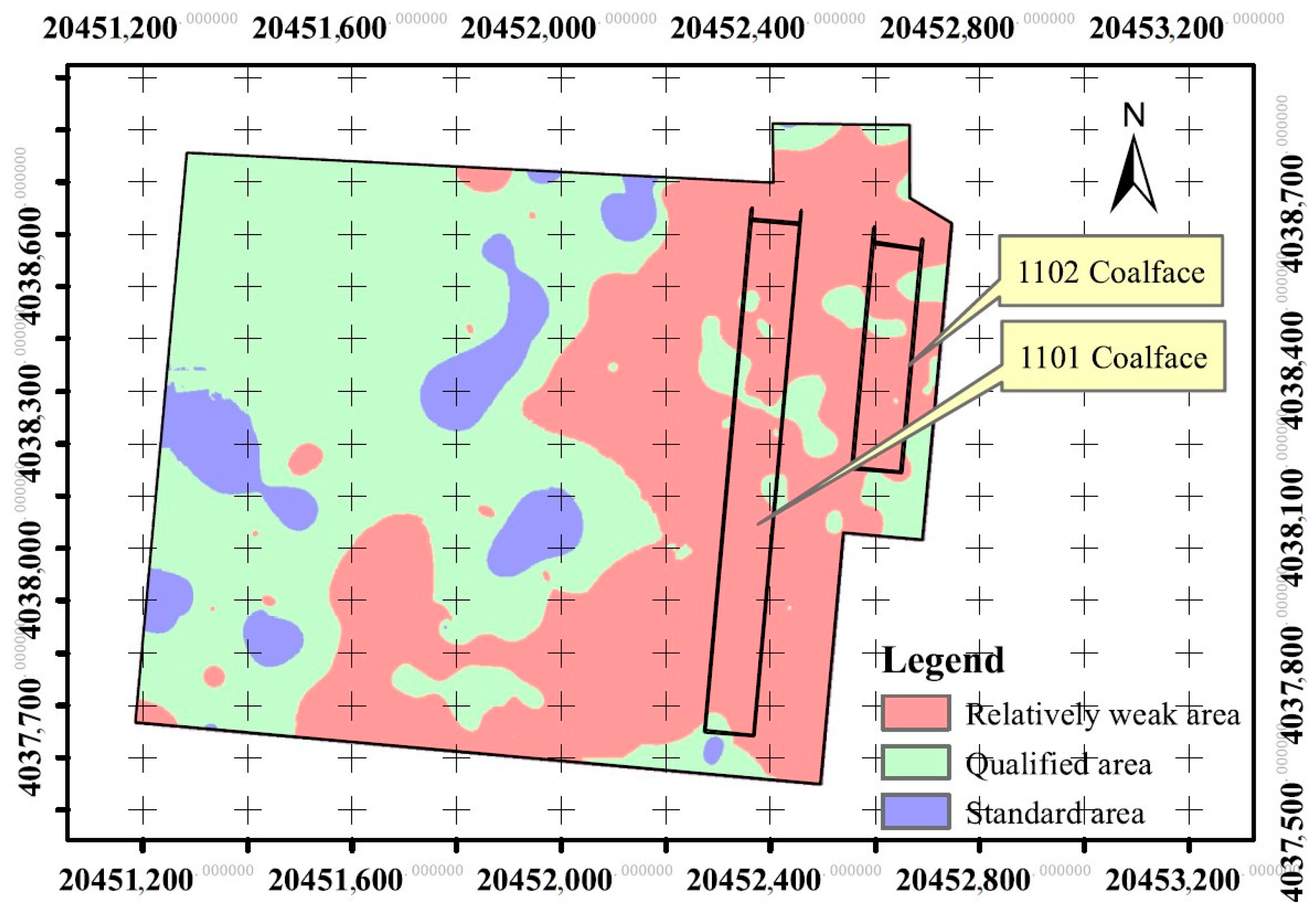

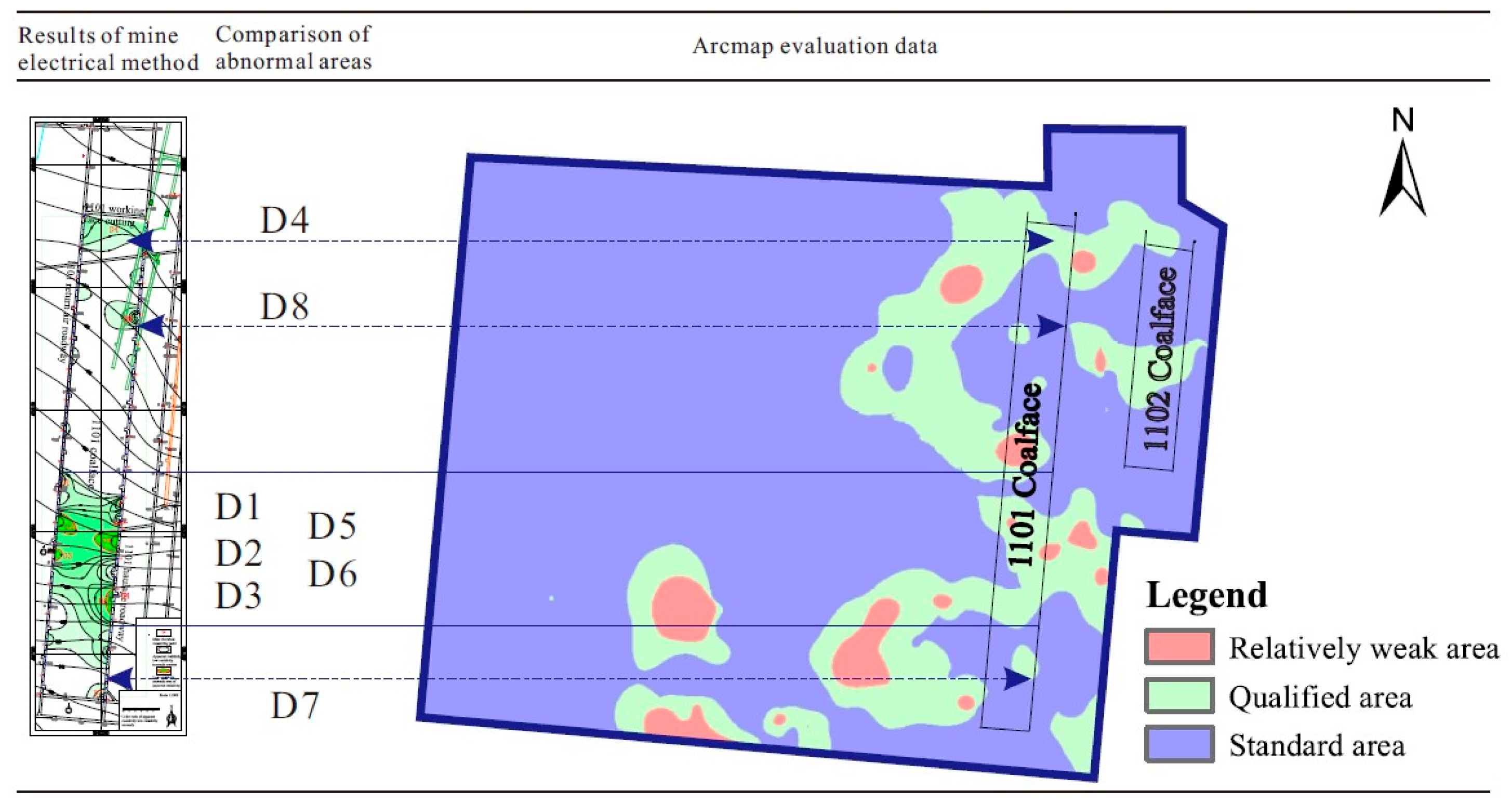
| Coordinate Data | Grouting Pressure (MPa) | Coordinate Data | Grouting Pressure (MPa) | ||
|---|---|---|---|---|---|
| X452437.5230 | 4038813.3490 | 12.5 | X452736.4278 | 4038528.3160 | 10.7 |
| X452486.9740 | 4038814.8070 | 11.5 | X452465.9240 | 4038513.8370 | 9.7 |
| X452551.5840 | 4038815.7270 | 10.5 | X452647.1340 | 4038501.4170 | 10.7 |
| X452616.2240 | 4038791.7870 | 11.0 | X452476.5040 | 4038472.6170 | 10.3 |
| X452691.3240 | 4038799.8670 | 10.5 | X452527.1340 | 4038468.6470 | 11.5 |
| X452422.3840 | 4038744.1370 | 10.0 | X452397.3540 | 4038434.5770 | 9.9 |
| X452514.7740 | 4038739.6570 | 10.0 | X452389.1240 | 4038426.3170 | 11.5 |
| X452558.8490 | 4038712.1650 | 10.5 | X452358.2940 | 4038413.2270 | 9.1 |
| X452632.3040 | 4038732.3570 | 10.0 | X452350.4540 | 4038392.6070 | 10.1 |
| X452729.1340 | 4038741.6870 | 11.5 | X452202.4180 | 4038675.7640 | 9.5 |
| X452632.3040 | 4038732.3570 | 10.0 | X452095.3780 | 4038457.3940 | 9.5 |
| X452729.1340 | 4038741.6870 | 11.5 | X452058.1480 | 4038379.9240 | 9.5 |
| X452661.3340 | 4038683.6270 | 11.0 | X452278.5880 | 4038706.4540 | 10.0 |
| X452727.4340 | 4038671.6870 | 10.1 | X452219.5380 | 4038617.8240 | 10.0 |
| X452401.7900 | 4038636.4498 | 10.0 | X452151.2580 | 4038517.0040 | 10.5 |
| X452420.8621 | 4038623.9074 | 10.0 | X452318.8980 | 4038671.3240 | 10.0 |
| X452461.6040 | 4038631.0770 | 10.5 | X452229.5380 | 4038562.5940 | 9.5 |
| X452547.8199 | 4038634.9909 | 9.5 | X452400.9434 | 4038658.9898 | 10.5 |
| X452539.4188 | 4038625.4052 | 10.0 | X452388.7580 | 4038647.8040 | 9.0 |
| X452791.7240 | 4038629.0870 | 10.6 | X452235.1183 | 4038509.2048 | 6.5 |
| X452482.5490 | 4038602.6720 | 10.0 | X452384.0080 | 4038563.4244 | 10.0 |
| X452565.7240 | 4038604.2770 | 10.0 | X452229.9085 | 4038458.0033 | 9.0 |
| X452640.9240 | 4038600.8270 | 9.8 | X452069.7166 | 4038346.5497 | 8.0 |
| X452382.5300 | 4038564.0498 | 10.0 | X452354.7337 | 4038469.1402 | 11.0 |
| X452645.2240 | 4038560.6670 | 10.0 | X452282.6517 | 4038435.1176 | 11.0 |
| X452416.0640 | 4038543.3770 | 10.5 | X452187.1680 | 4038389.8940 | 10.0 |
| X452472.7772 | 4038549.2587 | 7.0 | X452091.1480 | 4038345.8140 | 11.0 |
| X452539.6940 | 4038540.3670 | 10.0 | X452446.1880 | 4038427.0440 | 10.0 |
| X452584.7640 | 4038529.0570 | 10.4 | X452347.5180 | 4038399.4840 | 9.5 |
| …… | |||||
Disclaimer/Publisher’s Note: The statements, opinions and data contained in all publications are solely those of the individual author(s) and contributor(s) and not of MDPI and/or the editor(s). MDPI and/or the editor(s) disclaim responsibility for any injury to people or property resulting from any ideas, methods, instructions or products referred to in the content. |
© 2023 by the authors. Licensee MDPI, Basel, Switzerland. This article is an open access article distributed under the terms and conditions of the Creative Commons Attribution (CC BY) license (https://creativecommons.org/licenses/by/4.0/).
Share and Cite
Li, J.; Xu, Q.; Hu, Y.; Chen, X. Evaluation of Control Effect of Confined Water Hazard in Taiyuan Formation Coal Seam Mining in Huanghebei Coalfield. Water 2023, 15, 1973. https://doi.org/10.3390/w15111973
Li J, Xu Q, Hu Y, Chen X. Evaluation of Control Effect of Confined Water Hazard in Taiyuan Formation Coal Seam Mining in Huanghebei Coalfield. Water. 2023; 15(11):1973. https://doi.org/10.3390/w15111973
Chicago/Turabian StyleLi, Jingying, Qingguo Xu, Yanbo Hu, and Xinmin Chen. 2023. "Evaluation of Control Effect of Confined Water Hazard in Taiyuan Formation Coal Seam Mining in Huanghebei Coalfield" Water 15, no. 11: 1973. https://doi.org/10.3390/w15111973
APA StyleLi, J., Xu, Q., Hu, Y., & Chen, X. (2023). Evaluation of Control Effect of Confined Water Hazard in Taiyuan Formation Coal Seam Mining in Huanghebei Coalfield. Water, 15(11), 1973. https://doi.org/10.3390/w15111973






